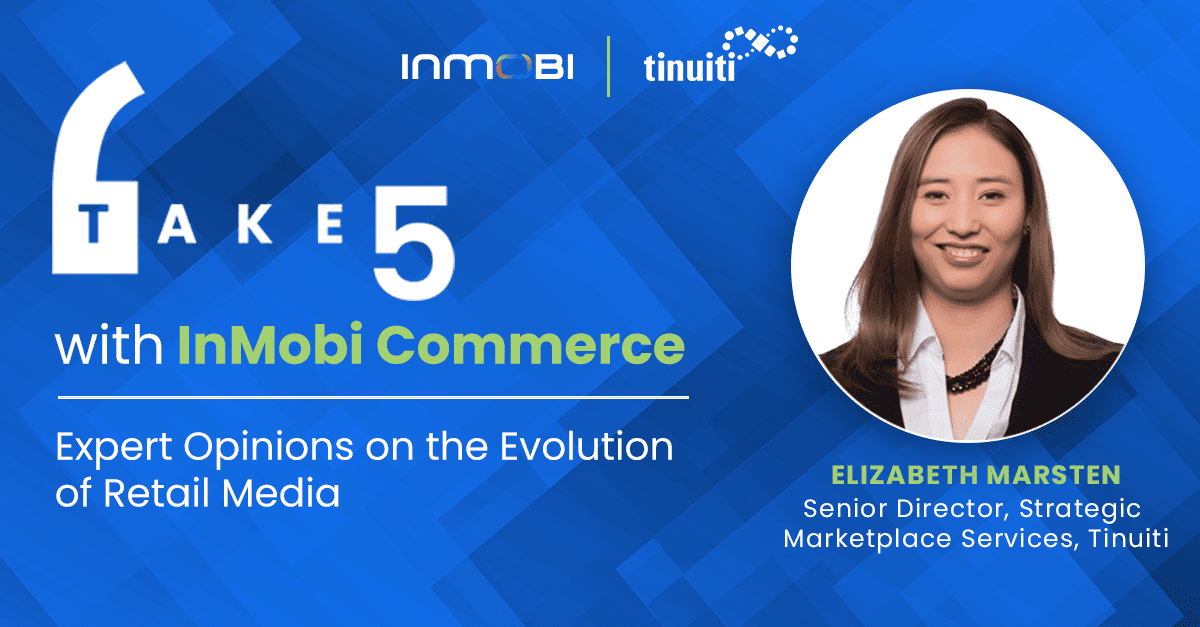- For Advertisers
-
For Publishers
- For Retail Media
- For Telcos
- Our Consumers
- Resources
- GET STARTED
-
Login Login

InMobi Commerce’s goal is to provide retailers and advertisers with all the tools they need to thrive in today’s retail media ecosystem. That includes talking with industry experts about emerging trends in retail media, tips on how brands and retailers can work together more successfully, and more.
In this edition of “Take Five,” Sarah Hughes, Head of Marketing at InMobi Commerce, sat down with Elizabeth Marsten, Senior Director, Strategic Marketplace Services at Tinuiti to discuss the rise of retail media and how brands and retailers should capitalize on this growing channel.
You can listen to the full interview here.
Well, first and foremost it’s Amazon, right? Amazon showed us that you can monetize your site for yourself very, very well. I mean, we had some folks that were doing it before, like with affiliate marketing, but not to the volume of Amazon. So, when a Walmart or Target thinks about the hundreds of millions of monthly visitors they get to their website, it sure does sound really good to monetize that site traffic.
Amazon was also able to prove that retail media was a good idea because they have the benefit of an e-commerce system. It’s a closed-loop naturally out of the gate. So, the conversion rates follow, then they start to build audiences, and then they start to really understand who the shopper is and all the fun things that they’re doing online.
So, tagging into what I was just talking about, it’s that closed-loop, right? Retailers need to be able to tie engagement with an online experience or exposure to my ad to an in-store purchase. For example, if I’m an endemic brand to Walmart, to a Target, to a Kroger, and I traditionally have 75 – 90% of my sales happening in-store, even if customers are having an online experience or having some kind of ad exposure, they are still going in-store to purchase.
That closed-loop capability for the in-store piece is so, so key. I need it like yesterday.
It’s tough, right? It’s like when you go to, I wouldn’t say we’re in college yet, more like high school – you have to choose your electives, but then there are those classes you have to take – or in this case, retailers that you have to engage with, in order to graduate, right?
You have to have this conversation with yourself as a brand, and say: “Where do we have to be? Where are we committed? Where do we need to be?”, and then back into it from there. Because it is really difficult on a per brand basis to definitively say, “put 30% in Walmart, put 20% in Target, and put 10% in Kroger." Depending on who you are and what your assortment is and your fulfillment capabilities and your distribution, that’s a totally different equation for everyone.
Sarah: And right now, do you see advertisers approaching their retail media strategy based on which retailers their revenue is coming from, or are they thinking about it from the perspective of “where is my target audience purchasing," or a little bit of both?
It’s definitely both. Brands have to honor those historical, developed retail relationships, right? That way you’re pushing product to your core audience that is familiar with your product and where to buy it, and then you have to get the new folks in.
There is a huge lifetime value in finding new customers. Brands have to ask themselves: “How do we find that age group that’s coming into college, graduation, first apartment? Where are they consuming content, and how do I get my product in front of them?” So, it’s a balance between honoring your core audience and making sure they know where your stuff is and that it’s available and you’re there for them. And then finding the new folks, and where the cool kids hanging out.
Retailers need to be able to tie engagement with an online experience or exposure to my ad to an in-store purchase.
So, I think as an industry, we have to mature, right? Retail isn’t really known as like the innovative like “go, go get it” right? Like, that’s just not what they do. And these are huge organizations that we’re asking to change.
Part of it has to do with integrating this digital experience, this digital media with the in-store experience, but also the physical end-to-end right? We’re talking about negotiations with the buyer, line reviews, fulfillment, distribution. Is it better for my brand margin-wise to be only on a dot com, or should I be focusing on physical in-store expansion? So, there is a lot of work that needs to be done, in terms of how the model needs to change, but then from a customer perspective right, there needs to be continuity in messaging.
I can’t have a message shown to me on a streaming platform or see a Facebook ad and then go into the store, and none of it matches. Like that’s not a good experience. Especially, for example, if you have new products, right? The messaging needs to be consistent, but also the way the messaging is brought to life needs to be consistent as well. You don’t want to go into the store — like it’s not a good experience — when you see the really shiny, really cool video on TikTok or like OTT and then you go into the store and it’s like this physical paper display from like 1998, it doesn’t give you confidence as a consumer.
Sarah: Do you see personalization playing a role in unifying the online to in-store experiences?
Absolutely. One of the total personalization lay-ups on the retail side that I don’t see as many retailers as I think we should take part in is, “You May Also Like”. Recommendation engines are a fantastic basket builder, and I fall party to it every time, every time. In fact, sometimes, I’ve become reliant on looking in that section to see what else there is.
So, to your point earlier about personalization, I do think we’ll see a little bit more of that. But the way we are going to see retailers personalize shopping will be less subtle than what Facebook and Google do, where they just slide it in based on other things. Retailers are going to be approaching personalization more directly – it’s going to be like that product recommendation engine, “things you also bought," the ability to favorite items or add items to a list, right? So, personalization to help curate your own kind of retail experience.
I’d be remiss if I didn’t also mention retailers expanding into programmatic. How do you not as a retailer? Retailers are not media companies, and if we expect them to be both and do both really well and they’re living in the shadow of Amazon and Google this isn’t going to go well for us. We are going to be frustrated, and it’s going to feel slow. So, if retailers can remove their first-party data from behind those walls of management or walled gardens and can turn it into audiences that we can buy — through a platform like The Trade Desk or DV360 — now you’ve taken that data and you’ve let the people who do this for a living run with it. And now we can actually see the strength of the first-party data.
Obviously, there’s going to be more retailers launching networks, everybody is going to do it. I’m actually really curious to see how many more third-party marketplaces pop up. Because if you’re on Amazon and you want to kind of split out your catalog and have a few different eggs in a few different baskets, depending on what you sell, specialty retailer third-party marketplaces could be really good for you. They won’t have the volume of Amazon, no one’s going to show up tomorrow with another Amazon, so, why make that comparison? Instead, dig in and lean into the audience. When someone selects the Home Deport or shops at Ulta – they have a very specific reason. They’re not going “oh, I also need eggs”, right? They went there for a reason. Why not lean into and take advantage of those capabilities? You’ve just got to look at each of those retailers and say: all right, are my people there? And if yes, in this next year, let’s lean in!
To hear more from Elizabeth, you can listen to her full interview here, read her series in Adweek or follow her on LinkedIn. If you’d like to provide your expert opinion for our next Take Five interview, contact us today!

About Elizabeth:
Elizabeth is the Senior Director of Strategic Marketplaces Services at Tinuiti, where she works with teams in advancing cross-functional strategic enterprise services through partner development, advertising and sales support on retail media channels, such as Walmart, Target, Instacart, Kroger, Criteo Retail Media and more.
With more than 15 years of e-commerce and digital marketing experience, Elizabeth is a noted industry expert and has spoken at many of the leading marketing conferences in North America and is also a regular contributor to AdWeek on retail media.
Register to our blog updates newsletter to receive the latest content in your inbox.